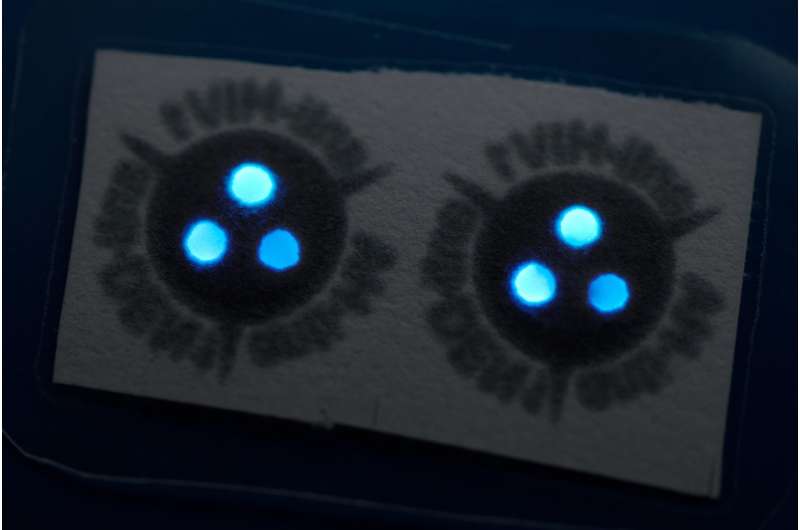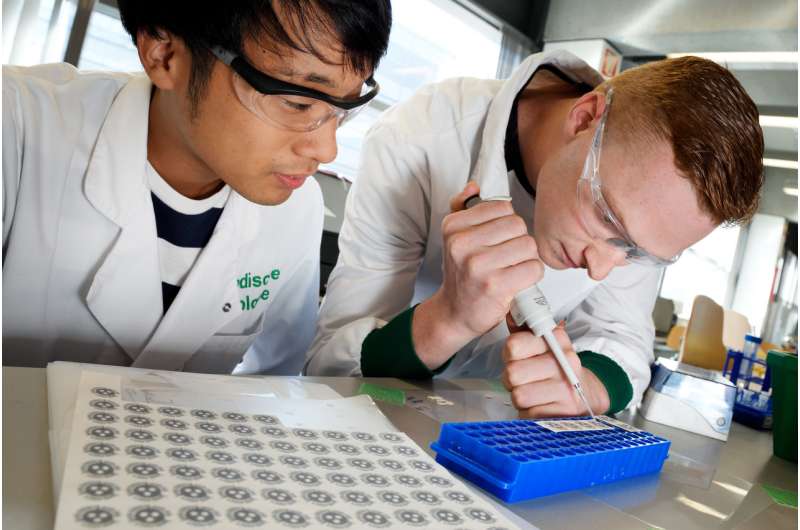Glow-in-the-dark paper as a rapid test for infectious diseases

Researchers from Eindhoven University of Technology (The Netherlands) and Keio University (Japan) have presented a practicable and reliable way to test for infectious diseases in Angewandte Chemie. The simple technique uses a special glowing paper strip, a drop of blood and a digital camera. The technology is inexpensive and fast—after 20 minutes, it is clear whether there is an infection; it also makes expensive and time-consuming laboratory measurements in the hospital unnecessary. In addition, the test has a lot of potential in developing countries for the easy testing of tropical diseases.
The test shows the presence of infectious diseases by searching for certain antibodies in the blood produced in response to viruses and bacteria. The development of handy tests for the detection of antibodies is in the spotlight as a practicable and quick alternative to expensive, time-consuming laboratory measurements in hospitals. Doctors are also increasingly using antibodies as medicines, for example, in the case of cancer or rheumatism. So this simple test is also suitable for regularly monitoring the dosage of such medicines and making corrective measures in good time.
Using the paper strip, developed by the Dutch and Japanese researchers, is simple: A clinician applies a drop of blood to the strip, waits 20 minutes, and turns it over. "A biochemical reaction causes the underside of paper to emit blue-green light," says Eindhoven University of Technology professor and research leader Maarten Merkx. "The bluer the color, the higher the concentration of antibodies." A digital camera, for example, from a mobile phone, is sufficient to determine the exact color and thus the result.

The color is due to a luminous sensor protein developed at TU/e. In response to a drop of blood, this protein triggers a reaction that produces blue light via bioluminescence. Such enzymes also illuminates fireflies and certain fish, for example. In a second step, the blue light is converted into green light. If an antibody binds to the sensor protein, it blocks the second step. A lot of green light means few antibodies and, vice versa, less green means more antibodies.
The ratio of blue and green light can be used to derive the concentration of antibodies. "So not only do you know whether the antibody is in the blood, but also how much," says Merkx. By measuring the ratio precisely, the test is more accurate than other biosensors. In their prototype, they successfully tested three antibodies simultaneously, for HIV, flu and Dengue fever. Merkx expects the test to be commercially available within a few years.

More information: Keisuke Tenda et al, Paper-Based Antibody Detection Devices Using Bioluminescent BRET-Switching Sensor Proteins, Angewandte Chemie International Edition (2018). DOI: 10.1002/anie.201808070
Journal information: Angewandte Chemie , Angewandte Chemie International Edition
Provided by Eindhoven University of Technology


















